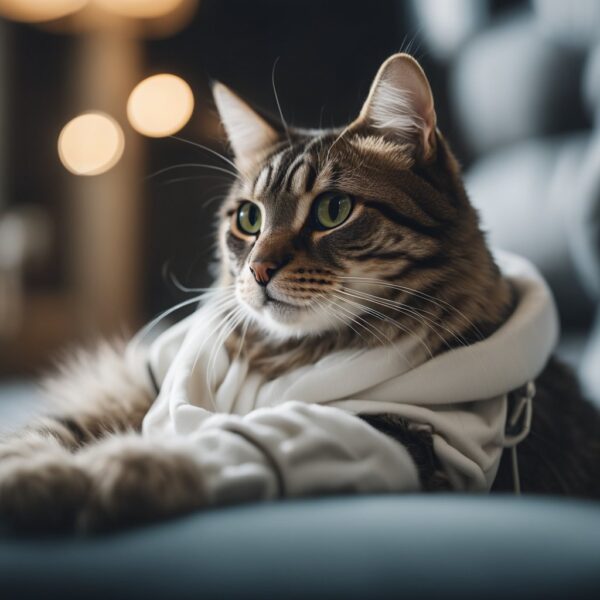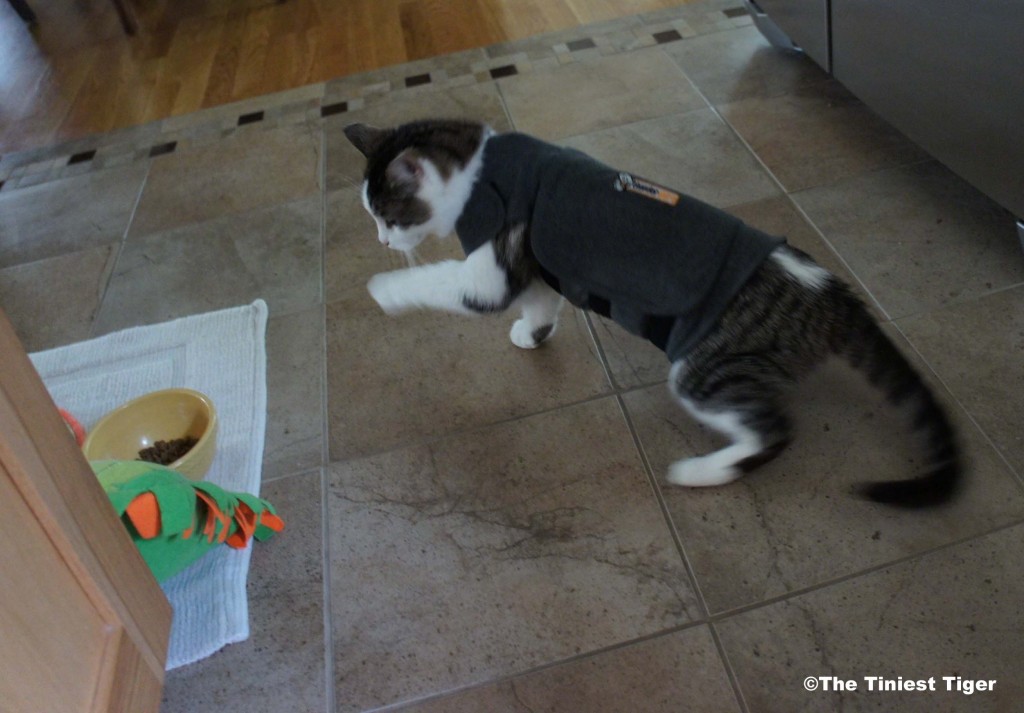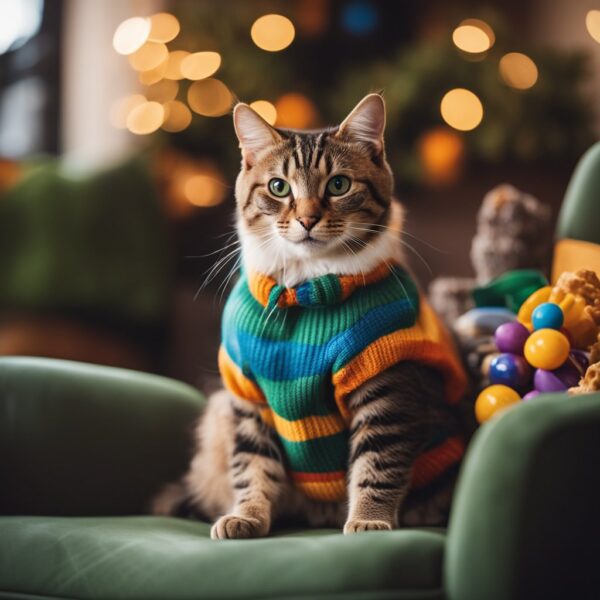
Why Cats Freeze and Fall Over wearing clothes
Cats freeze and fall when you place clothing on them due to instinct. The fight, flight, or freeze response refers to the involuntary physiological changes happening in the body and mind when a cat feels threatened. This can cause rapid breathing, tense muscles, and more.
The cat freeze and fall response exists to keep cats safe, preparing them to face, escape, or hide from danger. However, cats can experience this response whether the danger is real or not. This can lead your cat’s response activating in situations where it is not necessary, such as cats wearing clothes. Cats can also react to perceived threats in different ways, which is where the name “fight, flight, or freeze” comes from.
Cats have their fur to protect them from external factors and do not require clothing. However, some cat parents may still attempt to dress their cats, which often leads to the feline falling over or freezing. This perplexing behavior warrants a deeper look into why cats react this way to clothing and whether or not they should wear clothes in the first place.
Not all cats enjoy wearing clothes, as it can restrict their movement, obscure their vision, and inhibit their ability to use body language. In some cases, the overstimulation of their senses may cause cats to freeze or fall over when clothed.
Key Takeaways
- Cats may fall over when wearing clothes due to restriction, impaired vision, and sensory overload.
- Dressing up cats might not be necessary, as their fur provides them with adequate protection.
- Considerations should be made regarding feline comfort and safety when deciding on clothing for cats.
Why Cats Freeze and Fall wearing clothing
Reason 1: Fearfulness
Cats may freeze and fall over when wearing clothes because they are scared of the unfamiliar sensation. Wearing a costume, especially if they have never worn a harness or collar before, can be a frightening experience. Additionally, certain costume designs or attached accessories can provoke fear in your cat.
Reason 2: Feeling Constrained causes Cats to Freeze and Fall
Cats greatly depend on their agility and communication through body language. Clothing restricts their range of motion, making them feel uneasy. Depending on the individual cat’s temperament, they may instinctively flop down, immobilized by their costume.
Reason 3: Sensory Overload
Cats are sensitive to touch, and their responses vary based on the area being touched. Clothing can overstimulate them when it covers several sensitive areas simultaneously. This heightened sensitivity may cause your cat to freeze and fall down on their side when dressed in clothes.
Reason 4: Impaired Vision
As predators and prey, cats rely on their vision for survival. If their vision is obscured by a costume, they may become frightened and panic due to their decreased ability to defend themselves. Costumes that block their peripheral vision can lead to this immobility.
Reason 5: Unpleasant Odors
Cats’ keen sense of smell is vital for communication, and they use scent to mark their territory and establish security. An unfamiliar or chemically induced scent from clothing can be alarming to a cat. Additionally, clothes that limit their grooming abilities may cause stress, leading them to fall over.
Reason 6: Improper Fit
If a formerly tolerant cat suddenly falls over when wearing clothes, the issue might be the clothing’s fit and material quality. Poorly made, heavy, or tight garments can cause discomfort or pain and potentially restrict their mobility. Narrow elastic bands around the legs or neck can be problematic as well.
Reason 7: Excessive Attention May Cause Freeze and Fall
Some cats may be able to wear clothes without issue, but when overwhelmed by the heightened responses from humans, they may feel uncomfortable. In some cases, cats may freeze and fall over to avoid the unwanted attention they receive when dressed up.
Reason 8: Nonviolent Protest: The cat freeze response
Cats have different personalities and responses to situations. While some might aggressively resist clothes, others may twist their bodies to escape. In contrast, others might freeze and fall over as an act of protest, signaling their dislike for the situation. If this occurs, removing the clothing is the most compassionate response.
Why Do Cats Hate Clothes? The Cat Freeze Response
Cats tend to dislike wearing clothing due to the unnatural feeling of restriction it imposes on them. They rely on their fur to regulate body temperature, so putting clothes on them is conflicting with their natural instincts.
Some factors contributing to a cat’s aversion to clothes include:
- Fear of restriction: Cats may feel trapped or unable to move freely when dressed in clothing.
- Unfamiliar sensations: The smell, texture, and sound of clothes may be uncomfortable or disorienting for cats.
- Fight or flight reactions: In many cases, clothing triggers a defensive response in cats.
However, if a cat has been gently introduced to clothing since its kittenhood, their reaction might be more mild. In general, it is best to respect a cat’s natural instincts and refrain from dressing them up unless absolutely necessary, such as in a medical situation where a veterinarian advises it.
Should cats wear clothes?
In general, there isn’t a strong justification for clothing cats. Their fur naturally serves as protection, and they typically regulate their body temperature well. In fact, putting clothes on cats can present several risks, such as overheating or injuries, especially for outdoor cats that may get caught on something.
Additionally, clothes can obstruct cats’ normal activities like grooming or using the litter box, potentially leading to stress and health issues.
While there are specific situations where cat clothing might offer benefits, such as keeping hairless or shaved cats warm during colder weather and preventing self-inflicted injuries, most cat clothing on the market are intended for entertainment rather than practical use. Given the risks and minimal benefits associated with dressing cats, it’s generally safer to avoid doing so.
When Is It Appropriate to Dress Your Cat?
Dealing with Skin Conditions
Cats might experience various skin issues, such as alopecia due to excessive grooming or hair loss. Potential causes include flea infestations, allergies, or skin irritation from parasites. To prevent your cat from over-grooming or scratching affected areas, consider asking your veterinarian about dressing your cat in soft, cat-friendly clothing. This approach can help protect their skin, as long as it doesn’t cause further discomfort.
During the Recovery Process
After surgeries or medical treatments, it’s crucial to keep your cat from disturbing wounds or consuming applied medication. In these situations, a sweater can help keep your feline warm while preventing them from licking their incisions. Make sure the clothing isn’t too tight and doesn’t restrict your cat’s movement.

Addressing Behavioral Concerns
Although many cats dislike wearing clothes, specific garments can alleviate anxiety. For example, a Thundershirt for cats applies gentle, constant pressure around your cat’s body, helping relieve stress-related conditions. Thundershirts have been reported to help reduce anxiety during situations like vet visits, travel, thunderstorms, and fireworks.
Ensuring Warmth
Cats rely on their fur to maintain an appropriate body temperature throughout the year. Cats with hairless or thin coats, such as Sphynx or Cornish Rex breeds, may require clothing for added warmth during colder seasons. Consider providing these cats with comfortable, non-restrictive clothing to help them stay warm, especially if the temperature is uncomfortable for you.
Overall, it’s essential to consult with your veterinarian and pay close attention to your cat’s comfort and tolerance levels when using clothes for any of the reasons mentioned above.
How To Teach Your Cat To Wear Clothes?
Utilize Cat-Specific Clothing
Be sure to research and find clothing specifically designed for cats. This ensures that your cat can still carry out basic tasks such as eating, drinking, using the bathroom, and moving around without restrictions. Also, the clothing should not obstruct their vision, tail, or ear movement.
Select the Appropriate Size
Understand that cats come in various shapes and sizes, and choosing the right size clothing for your cat is crucial. Look for a comfortable fit that does not restrict their movement or cause discomfort.
Maintain Simplicity
Aim for clothes with fewer accessories, avoiding features like capes, wings, or hoods, which may obstruct their vision or produce strange sounds. Check the clothing for any strong scents that might be off-putting to your cat.
Monitor Their Reaction
Introduce the clothes to your cat by leaving them in their favorite spot, allowing your cat to become familiar with the smell and texture. Gradually and gently dress your cat, observing their reaction. If your cat becomes agitated, remove the clothes. But if they remain calm, continue monitoring them while they wear the attire, ensuring they don’t become distressed.
Utilize Rewards
Make the experience positive by offering treats during the dressing process and engaging them with their favorite toys afterward. This helps your cat associate clothing with a positive experience while also demonstrating that their movement isn’t hindered.
Refrain from Punishment
If your cat reacts negatively to wearing clothes, do not punish them. Remain patient and understanding, using rewards and praise to create a positive association. Should your cat need clothing due to a medical or behavioral condition, consult your vet for guidance. Remember that wearing clothes isn’t a natural experience for cats, and their discomfort should be considered.
Do Cats Require Winter Attire?
Cats naturally adapt to varying temperatures by growing a denser fur coat during the colder months and shedding it as the weather warms up. This innate ability enables them to maintain their body temperature without the need for additional clothing. In fact, sweaters and other winter garments might cause even short-haired cats to overheat.
However, there are exceptional cases where hairless breeds, such as the Sphynx, could benefit from wearing a sweater in winter, but only if they are comfortable in clothing. Forcing them to wear clothes might lead to stress, and prolonged stress could ultimately result in health complications.

Cats Clothing is Designed for the human’s Entertainment and not the well-bing of the cat
For the majority of animals, including cats, being unclad is their natural state. Some cats may accept wearing items like sweaters or shirts occasionally, and if their owner is constantly monitoring them, putting clothes on a cat isn’t inherently negative.
Dressing up can benefit cats with medical issues that need protection through clothing. However, it’s essential to emphasize that for a healthy feline, clothes are generally unnecessary. Most cat clothing items are designed with the owner’s delight in mind, rather than the cat’s well-being. As responsible caretakers, our priority should always be the happiness and comfort of our feline companions.
Closing Thoughts on cats in Clothes
Considering the well-being of our pets, it might be best to let cats embrace their natural state, free from clothing restrictions. Their beautiful fur is already a perfect outfit, isn’t it? Keeping a watchful eye on our feline friends’ reactions to clothing is crucial to ensure their happiness and stress-free existence. So, it’s essential to respect their natural preferences and allow them to roam around the house comfortably without any additional attire.
Frequently Asked Questions
What makes cats Freeze and Fall when dressed up?
Cats may freeze and fall wearing clothing due to feelings of fear or restriction. The unfamiliar sensation of wearing clothes can make them uncomfortable and lead to the cat freeze response.
How does a harness impact a cat’s movement?
A harness could cause similar reactions in a cat as clothing, making them feel restricted and uncomfortable. Some cats may freeze and fall over, while others may get used to it over time. It is essential to always monitor your cat’s comfort when introducing something new like a harness.
Is it usual for cats to freeze and fall while wearing clothes?
It can be normal for some cats to lie down when wearing clothing because of the strange sensation they experience. They may be trying to cope with the feeling of the clothes by lying down or may be unable to move due to feeling constricted and the cat freeze response.
Can clothes make cats lose their balance?
Yes, clothes can cause some cats to lose their balance. Clothes may create extra weight or bulk, which disrupts their natural mobility and balance, particularly if the clothing is not well-fitted.
What should I do if my cat freezes and falls when wearing a harness?
If your cat stops moving when you put a harness on them, remove the harness immediately and assess their comfort level. It’s essential not to force your cat to wear a harness or clothing if it makes them uncomfortable or distressed.
Are there methods to help a cat adjust to a harness without Freeze and Fall?
To acclimate a cat to wearing a harness without causing them to freeze and fall over, you can:
- Introduce the harness gradually, allowing them to sniff and interact with it before attempting to put it on.
- Use positive reinforcement, such as treats and praise, to create a positive association with the harness.
- Start with short periods of wear, gradually increasing the time spent wearing the harness.
- Monitor your cat’s comfort and reactions closely, removing the harness immediately if they show signs of distress or discomfort or the cat freeze response.